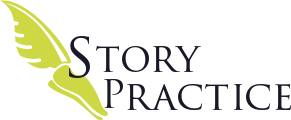
Projects, Storytelling & Collaboration
I hope that you have arrived on this post with an interest in creating new products and experiences for customers as well how storytelling creates perspective and meaning for human beings while we go about our work and daily lives.
Project methodologies and storytelling are means to collaboration. There are many methodologies or frameworks such as Waterfall, Agile/Scrum, SAFe, Lean, etc. All methodologies include ways of organizing people, time, and resources to optimize collaboration with the intent of delivering products and services. Organizations choose project methodologies for different reasons depending on the type of project being delivered, the company culture, and the latest ecosystem. Although project methodology may change, storytelling is essential in every methodology as a dimension of engaged communication.
Collaboration occurs through storytelling. In order to collaborate we must find common purpose so that we can build and foster relationships for cooperative work. Prior to the Covid-19 pandemic, many organizations were working in open floor plans with few barriers between co-workers to facilitate planned and serendipitous storytelling. In the past, I have benefited from catching snippets of conversation from other teams’ projects or concerns from the release manager who sat two seats away from me. It has been difficult to replace the conversations that used to happen over casual meetings in common spaces like the office kitchen or the hallway meeting after the official meeting when the interpretation is exchanged. (Much of that is happening off property in text on mobile phones.) The Zoom Happy Hour has been part of the effort to keep telling spontaneous stories.
A key part of collaboration is empathy among team members. When team members are able to share stories about their work and daily life, we are able to see them as multi-faceted persons. Conceptions about a co-worker initially formed by fleeting impressions change when there are opportunities to listen to them speak about their approach to work as well as events in their lives. These stories can reveal hidden skills and abilities as well needs for resources and training. They may also reveal personal challenges which can be overcome with the support of the team or resources from the organization. As a servant leader it is important to guide conversation within groups so that everyone has opportunities to tell their story, part of inclusion. It is also important to set respectful boundaries within the team or organization for personal as well as legal considerations.
Storytelling increases accountability in collaboration when it is used to drive team cohesion and role expectations. In Scrum the daily stand-up is a short story, on the surface it is a simple recitation, “What I did yesterday, what I will do today, name any roadblocks.” This is a daily installment on the health of the work planned for a given sprint. The Sprint Retrospective is the time and space for more elaborate storytelling within the team that can reveal interpersonal issues as well as planning and resource issues. It is important to note that storytelling in this sense does not include fantastical yarns. The focus is on conveying information and interpretation of that information to determine the health of the team and the project.
As a servant leader I am responsible for curating the storytelling occurring within a team. It is not productive for team members to stray off topic for long periods of time or deliver screeds counter to the purpose of gathering. A well-constructed agenda with defined time boxes helps form a team that improves their storytelling to convey the most pertinent information.


